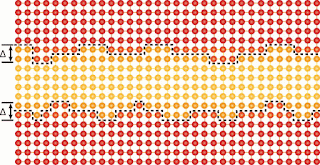 |
| FIG. 1. |
Even between lattice-matched crystalline materials, there exist nonuniform transition layers that behave as an effective atomic-scale interface roughness with some rms height Δ. This effective interface roughness leads to phonon-momentum randomization and to interface resistance in cross-plane transport.
Citation: J. Appl. Phys. 118, 175101 (2015); http://dx.doi.org/10.1063/1.4935142
Topics: Applied Physics, Materials Science, Nanotechnology, Phonons, Semiconductor Technology, Solid State Physics, Thermodynamics
Abstract
This paper presents a semiclassical model for the anisotropic thermal transport in III-V semiconductor superlattices(SLs). An effective interface rms roughness is the only adjustable parameter. Thermal transport inside a layer is described by the Boltzmann transport equation in the relaxation time approximation and is affected by the relevant scattering mechanisms (three-phonon, mass-difference, and dopant and electron scattering of phonons), as well as by diffuse scattering from the interfaces captured via an effective interface scattering rate. The in-plane thermal conductivity is obtained from the layer conductivities connected in parallel. The cross-plane thermal conductivity is calculated from the layer thermal conductivities in series with one another and with thermal boundary resistances (TBRs) associated with each interface; the TBRs dominate cross-plane transport. The TBR of each interface is calculated from the transmission coefficient obtained by interpolating between the acoustic mismatch model (AMM) and the diffuse mismatch model (DMM), where the weight of the AMM transmission coefficient is the same wavelength-dependent specularity parameter related to the effective interface rms roughness that is commonly used to describe diffuse interface scattering. The model is applied to multiple III-arsenide superlattices, and the results are in very good agreement with experimental findings. The method is both simple and accurate, easy to implement, and applicable to complicated SL systems, such as the active regions of quantum cascade lasers. It is also valid for other SL material systems with high-quality interfaces and predominantly incoherent phonon transport.
Journal of Applied Physics:
Thermal conductivity of III-V semiconductor superlattices, S. Mei, I. Knezevic
Comments